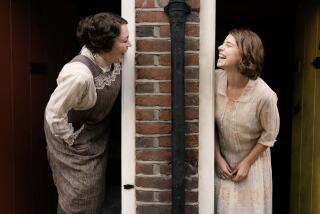Book review: ‘Kiss Her Goodbye’ by Mickey Spillane and Max Allan Collins
The new Mike Hammer novel “Kiss Her Goodbye” is preceded by a note from its co-author, Max Allan Collins, who explains that Mickey Spillane, the week before his death in July 2006, told his wife, “When I’m gone … [t]ake everything you find and give it to Max — he’ll know what to do.”
A reputedly astute businessman as well as a crime-writing legend, Spillane was right to place his trust in Collins, an outspoken fan and, since the early 1980s when they met at a mystery convention, a friend and sometime collaborator.
A prolific novelist (the award-winning Nathan Heller series, the graphic novel “Road to Perdition”), Collins clearly did know what to do with the notes, outlines, chapters and partially completed novels, some dating back to 1948, that Jane Spillane found in her husband’s offices at their South Carolina home. One of his initial tasks was the editing and completion of “The Goliath Bone,” the novel with which Spillane hoped to bring the Hammer saga to its chronological close. Published in 2008, it placed the aging but still ultra-hard-boiled hero in a post-9/11 New York, battling Islamic terrorists for possession of the biblical giant’s femur. Like much of the writer’s canon, it was as critically undervalued as it was highly entertaining.
Since then, the Hammer projects (as opposed to Spillane’s other Collins-completed novels, including the 2007 thriller “Dead Street” and the forthcoming “The Consummata,” both from Hard Case Crime) have included several full-cast original audio capers starring Stacy Keach (arguably the best of the character’s interpreters) and last year’s “The Big Bang,” which had its middle-aged hero furiously dispatching villains in the swinging ‘60s.
“Kiss Her Goodbye,” which Collins says is based on two of Spillane’s uncompleted efforts, takes place a decade later. It opens with its hero in repose in Florida, not quite recovered from a gunfight with Manhattan mobsters, weak in body and soured on his once beloved New York. (Surprisingly, the “her” in the book’s title is not one of Mike’s “dolls,” but the city of “skyscraper tombstones.”) Still, all it takes to lure Hammer back to the Big Apple is a phone call from his best pal, NYPD detective Pat Chambers, and the news that the sleuth’s mentor, Bill Doolan, has killed himself.
His brogans once again planted on the mean streets of Fun City, Mike begins a “private investigation” of Doolan’s death. Before long he’s up to the snap brim of his porkpie hat in mobsters, drugs, smarmy politicos and a fortune in Nazi diamonds, while romancing a sultry queen of the disco and a beautiful, insatiable district attorney. The result may be something of a pastiche, but it’s an extremely well-constructed one, clearly designed to remind Spillane’s fans and enlighten the uninitiated as to why the names of both writer and creation have been synonymous with hard-boiled fiction for a long time.
Once again, as in “I, The Jury,” a friend’s death sends Hammer on a gun-in-fist quest for retribution. This leads to action sequences including a shootout in a mob hangout that more than matches the violence (and body count) of “One Lonely Night,” sex scenes reminiscent of those in the series and an ending that combines two of Spillane’s most notorious curtain scenes.
Additionally, there are amusing trappings of the ‘70s, including a trip past the velvet rope into the hottest disco den of the era, the fictional Club 52, where the detective observes “gladiators, barbarians, even one doll in a Marie Antoinette getup… Truman Capote, the mayor of New York… a skimming operation Vegas might have envied.…” Quite a spectacle.
“I just stood there,” Mike tells us, “like Dorothy getting a load of Oz for the first time.”
The key element to the novel’s success is its convincing re-creation of its iconic hero, worn and weary but as capable as ever when it comes to rendering vengeance of biblical proportions. “I was older,” he tells us. “I was jaded. I had changed. I was tired. I was retired. But I was still Mike Hammer.”
True that.
Lochte is the author of the forthcoming novel “Blues in the Night” and the co-author, with Al Roker, of “The Midnight Show Murders.”
More to Read
Sign up for our Book Club newsletter
Get the latest news, events and more from the Los Angeles Times Book Club, and help us get L.A. reading and talking.
You may occasionally receive promotional content from the Los Angeles Times.






